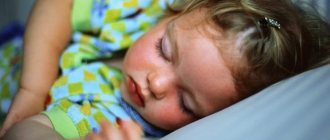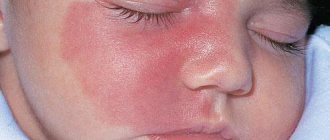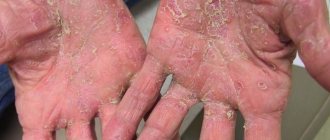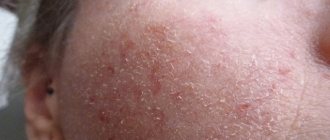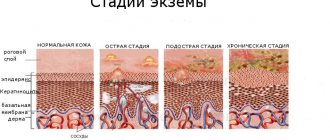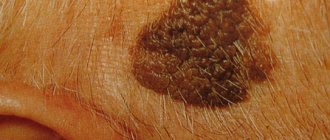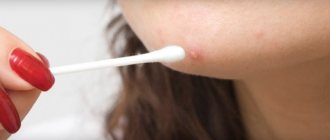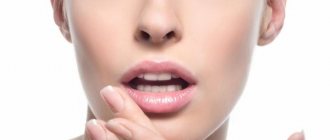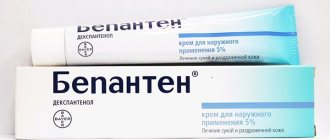Causes of eczema in children
Eczema occurs against the background of a combination of negative factors, which are divided into internal and external.
Internal factors:
- Chronic or acute diseases of internal organs.
- Disturbance in the functioning of the endocrine or nervous system.
- Bacterial or viral infections.
- Reduced immunity.
- Hereditary factor.
- Violation of the rules of the first complementary feeding or incorrectly selected artificial nutrition.
- Insufficient child hygiene, improper skin care.
- Hormonal imbalance – during puberty in adolescents.
External factors:
- Mechanical disorders of the skin - wounds/abrasions/diaper rash/wearing tight clothing or synthetic fabrics.
- Contact with chemicals (household chemicals); use of hygiene products containing aggressive components; abuse of antibacterial agents.
- Long-term use of potent medications.
- Burns/frostbite/prolonged exposure to direct sunlight.
- Constant contact with the source of the allergy.
Many experts believe that a complicated pregnancy can cause eczema in the child, as well as the presence of serious diseases in the mother - diabetes, vascular and heart diseases, etc.
The presence of helminths does not cause the development of the disease, but increases the risk of eczema.
Differential diagnosis
To make a correct diagnosis and find out the causes of eczema, it is recommended to carry out diagnostic measures:
- conducting a thorough examination of the baby;
- collection of blood and urine tests;
- taking skin samples to determine the allergen and skin scrapings for the presence of pathogenic microorganisms;
- the use of bacteriological culture to determine the sensitivity of the child’s body to various types of antibiotics.
Only after these procedures are appropriate therapy prescribed.
Types of eczema in children
Several types of eczema have been identified, they vary depending on the causes of occurrence, the location of the lesions and the symptoms of the disease.
- True
- Seborrheic
- Viral
- Bacterial
- Atopic
- Kaposi
- Coin-shaped
The most common among children is idiopathic (true), occurring in newborns (from 2 months). This form is characterized by a chronic course, and exacerbations in the autumn-spring period, when the immunity of children is threatened.
You can see what different forms of eczema look like in infants and older children in the photo section.
Symptoms of eczema in children
Eczema often appears on the cheeks (so it can easily be confused with a simple food allergy) and on the scalp, but can affect any part of the body, including the arms, legs and buttocks, and in advanced cases can be localized throughout the body. But each form has its own clinical picture:
- True - at the very beginning of the disease, scarlet or pink bubbles of different sizes may appear. The first rashes, which have cloudy contents, are localized in the face area, later moving to the folds of the arms and legs. After opening on their own, these areas dry out, forming an eroded area covered with crusts. In cases of teenage eczema caused by hormonal changes in the body, the former sites of localization of lesions may acquire bluish or purple shades, the eczema itself turns into a weeping form, and swelling of the affected skin areas is noted. Diseases in this form can go away on their own, and after a while they can arise again.
- Seborrheic - the exact reason why the development of this form begins is not known. Characteristic is the appearance of plaques on the scalp, which have a yellowish tint and are covered with scales, hence the flaking similar to dandruff. Such plaques can occur on different segments of the skin, but are rare. On skin where there is hair, the formation of plaques is due to a large number of ducts of the sebaceous glands. The lesions protrude above the level of healthy skin and are noticeable when touched.
- Viral - as the name implies, the development of the disease is caused by pathogenic viruses - influenza, chickenpox, rubella and herpes. Rashes in this form are localized on absolutely any segment of the skin - face, torso, limbs. Along with dermatological rashes, there is swelling of the skin, which is susceptible to rashes. The rash has a red tint and may be accompanied by itching.
- Bacterial – the second name for microbial, is caused by pathogenic microorganisms. The occurrence of this type is preceded by a bacterial infection. The symptoms of the disease are similar to those of viral eczema.
- Atopic – occurs against the background of constant contact with an allergen. The course of the atopic form does not differ from other types. It begins with the skin of the face and head, has a red tint, and if the disease is ignored, the development of weeping eczema is possible.
- Kaposi - the cause of this form is recognized to be the herpes virus type 8. It differs from other forms in the severity of its course, especially at an early age (infants and preschoolers) - there is an increase in body temperature, enlarged lymph nodes, and general malaise. The rash can be located on any segments of the skin, forming eroded areas as the disease progresses. Ignoring the disease in this case can provoke negative consequences for the child’s health.
- Coin-shaped - this form is rare in infants; the development of a coin-shaped form is often characteristic of older children. Oval or round plaques appear on the child’s body, most often on the back, buttocks or legs, which give the basis for the name. The plaques are flaky, they are covered with several layers of scales, and are red in color.
READ ALSO: Blisters on the face: possible causes, symptoms, diagnostic tests, medical supervision and treatment
We looked at the most common forms of eczema; there are also several rare forms - dyshidrotic, dry, mycotic (fungal), herpetic.
In addition to the forms of eczema, there are forms according to the course of the disease - acute or chronic. The stages of occurrence are also highlighted:
- Erythematous – the initial stage, hyperemia and swelling of the skin occurs.
- Blistering is the next stage; the rash area can reach three centimeters in diameter.
- Weeping - not typical for each form, but when the weeping stage occurs, the bubbles open, forming weeping areas.
- Crusty - wet areas dry out, forming flaky crusts.
- Chronic – areas of the skin prone to rashes become thicker and peel.
In addition to rashes, plaque formation and peeling, the following signs of eczema in children are identified: burning and severe itching, loss of appetite, general deterioration in physical condition, irritability, and sleep disturbances.
Description and symptoms
Eczema is a skin disease that appears in the form of rashes and redness. It is localized mainly on the legs, arms, face and abdomen. The danger is that it is difficult to get rid of it completely, so there is a high risk of relapse.
Location of eczema
External manifestations are similar to some other types of skin pathologies. Symptoms of the disease in children are as follows:
Areas of hyperemia have clear contours and signs of inflammation and swelling. Severe itching intensifies at night. This manifestation is dangerous because the child begins to scratch the affected area, and the risk of infection increases.
Eczema on the face
Treatment of eczema in children
Before starting treatment for eczema, it is important to establish an accurate diagnosis, because eczema rash may have similar symptoms to other dermatological diseases - herpes rash, diathesis, allergic manifestations, urticaria, lichen, etc.
In addition to separating eczema from other diseases, it is important to establish the cause of the disease in order to prescribe effective treatment. For diagnostic purposes the following is prescribed:
- General blood test - to identify inflammatory processes in the body (the ESR indicator can indicate this);
- Examination of separated particles of the dermis under a microscope - to exclude lichen and identify or exclude the presence of fungus and other viruses;
- Allergy tests – in cases of atopic eczema, to identify and eliminate the source of the allergy;
- Histological studies – to identify diseases of an autoimmune nature.
READ ALSO: Blue clay for face
Based on the diagnoses received and taking into account the age and characteristics of the body, the doctor prescribes treatment. Treatment of eczema involves complex therapy:
- Diet – nutrition is adjusted, diet changes. For bottle-fed children, a replacement formula is required; for older children, the exclusion of foods that can trigger allergies.
- Sedatives – to normalize sleep if necessary.
- Antihistamines - to relieve discomfort (itching, burning).
- Anti-inflammatory - tablets or ointments to relieve swelling of the skin and improve general condition.
- Vitamin complexes and/or immunomodulators - to increase or maintain immunity levels.
- Antibiotics or antivirals - in cases of bacterial or viral etiology.
For rapid tissue regeneration, physiotherapy can be prescribed - it is often used for treatment, especially in young children, when many medications cannot be prescribed due to age.
With eczema, it is very important to pay attention to hygiene - the child must be bathed twice a day, using only children's hypoallergenic products, not only detergents, but also skin care products (oils, powders, etc.).
READ ALSO: Lipoma: what is it, causes of origin, symptoms, methods of therapy |
In the presence of wounds and abrasions, antiseptic treatment is necessary to prevent secondary infections.
The prescription of medications itself is unacceptable; the dermatologist selects treatment individually, based on the tests obtained.
Prevention measures
- During pregnancy and especially during breastfeeding, be sure to follow a diet.
- Timely and gradual introduction of new food products into the child’s diet.
- Timely examinations by doctors, timely treatment of diseases before they become chronic.
- Attention to the environment in which the child grows up. Choosing the most environmentally friendly options for recreation, food and life.
- Scheduled vaccinations. Prevention of helminthiasis.
Children may have a predisposition to eczema, but it will not manifest itself without a stimulus, this could be exposure to an allergen, decreased immunity due to illness, poor diet, or severe stress.
To reduce the risk of disease, it is advisable for mothers during pregnancy and breastfeeding to eat a balanced diet and follow a diet, and also not to rush too much with complementary feeding and switching to artificial feeding.
Let's celebrate! If you notice the first symptoms, you should consult a dermatologist, and then follow the chosen treatment plan, eliminate the causes of the symptoms, and adjust your diet. Eczema is a chronic disease, but if you follow preventive measures, relapses can be avoided.
Treatment of eczema in children with folk remedies
There are many traditional medicine recipes for the treatment of eczema in children, but self-medication is unacceptable, even in relation to herbal medicine, because ignorance of the properties of some components can increase discomfort and harm the child’s health.
Often, alternative medicine recommends using herbs to make decoctions that should be added to water while taking a bath.
Common herbs that can be used are string, chamomile, calendula, hawthorn, motherwort, etc.
Preventive measures
To alleviate the child’s condition during seasonal exacerbations of eczema, as well as to prevent complex symptoms, parents should adhere to a number of recommendations. Expectant mothers should also adhere to generally accepted rules and an appropriate lifestyle. After all, it is the course of pregnancy, along with underlying heredity, that creates the foundation for the health of the baby, who will soon be born.
General recommendations include:
- organizing proper nutrition for the child;
- using cold compresses to relieve itching caused by the affected areas;
- monitoring the air temperature in the room of a sick child. Increased temperature will cause increased sweating, which is accompanied by the formation of salt on the surface of the skin. The salt released in sweat will provoke a new outbreak of burning and itching;
- prevent the child from overheating, both indoors and outdoors. The baby should be dressed according to the weather. Excessive wrapping has an adverse effect on delicate skin;
- Do not swaddle your newborn baby too tightly. Changing diapers must be combined with airing the skin;
- When bathing a child, there is no need to use shampoos and other detergents. No matter how they are “adapted by advertising” for the delicate skin of a baby, they sufficiently contain chemicals that can cause an allergic reaction;
- It is useful to add decoctions of chamomile and string to bathing water;
- when buying clothes, you should carefully study the composition of the fabric, it should be natural and soft;
- You may have to give up diapers for a while in favor of the old, proven method, in the form of swaddling;
- keep the baby’s body clean, change clothes in a timely manner, trim nails;
- If possible, in the summer, take the baby to the sea coast, where the healing air and water will have their therapeutic effect.
